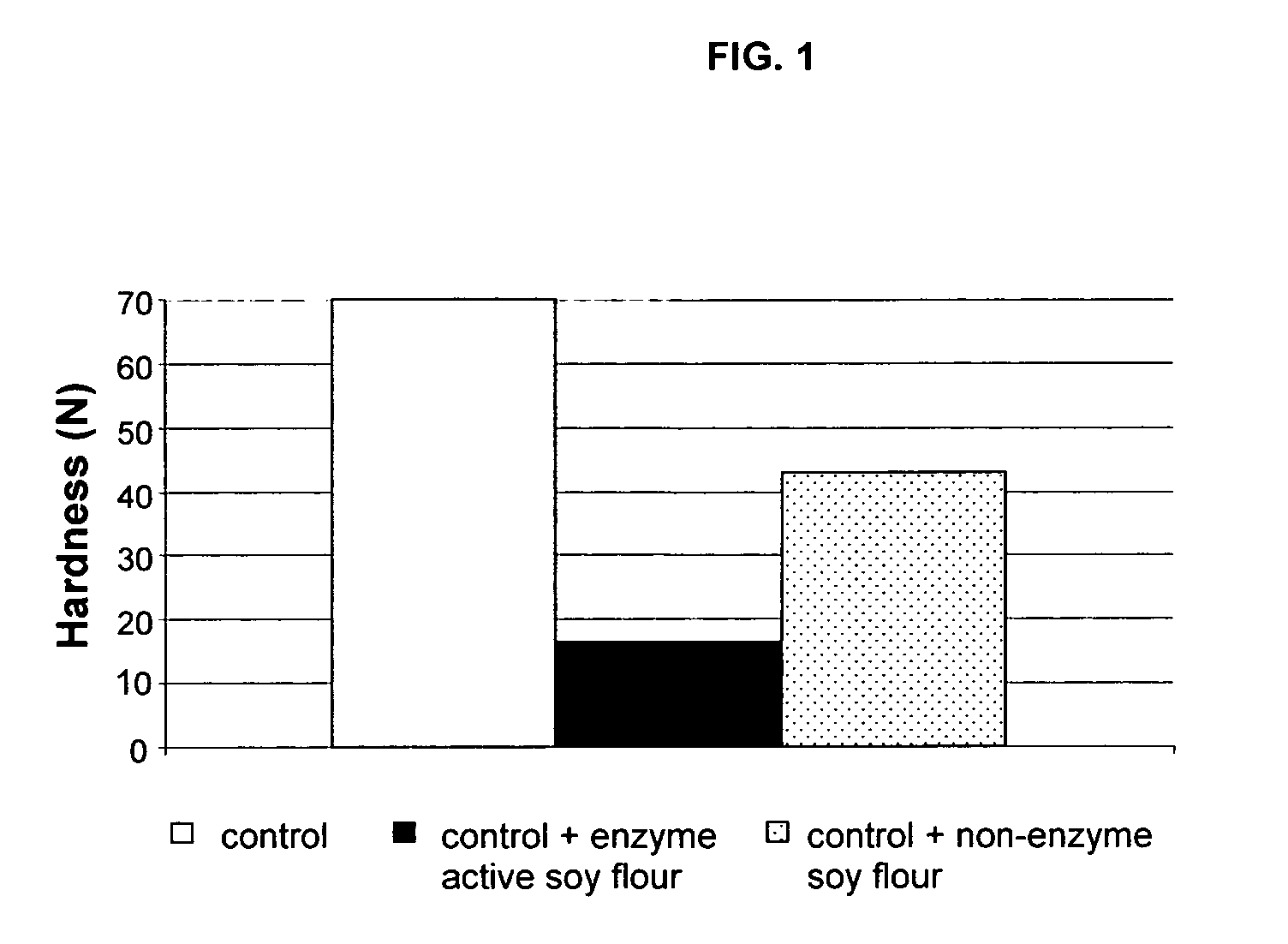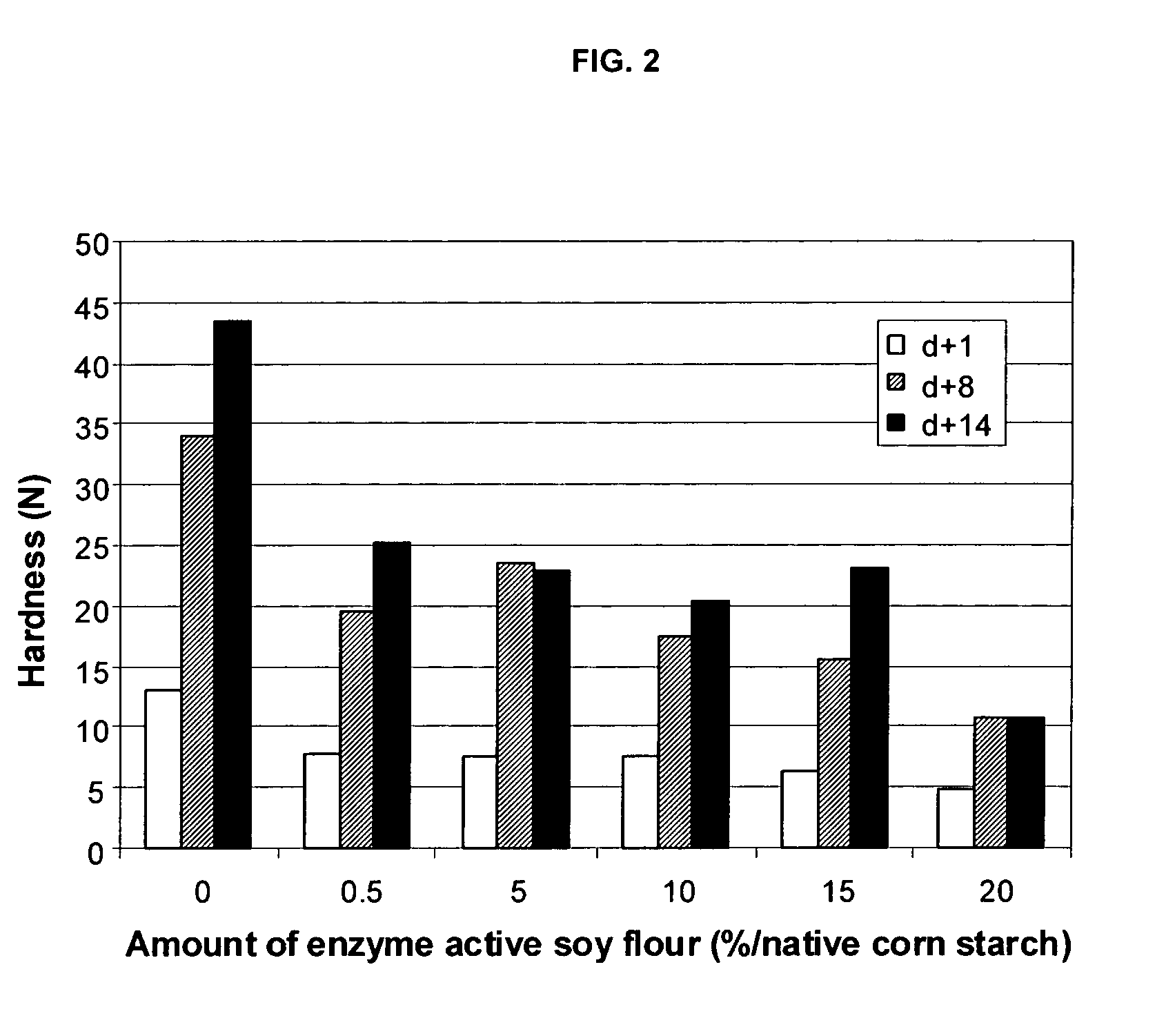Composition for preparing improved gluten-free or gluten-reduced bakery products
a technology for reducing gluten and bakery products, applied in the field of preparing gluten-free or gluten-reduced bakery products, can solve the problems of poor absorption of nutrients, health problems in predisposed individuals, and dough to swell or rise, and achieve the effect of reducing hardness, reducing the hardness of 16, and reducing the hardening of industrial gluten-fr
- Summary
- Abstract
- Description
- Claims
- Application Information
AI Technical Summary
Benefits of technology
Problems solved by technology
Method used
Image
Examples
example 1
Effect of Enzyme Active Soy Flour in a Gluten-Free Bread
[0049]This example illustrates the effect of partially substituting native corn starch of a gluten-free bread by enzyme active soy flour and toasted (non-enzyme) soy flour. First, a control dough was made using a recipe for a gluten-free bread. Further, two sample doughs were made using the same recipe, except that 20 wt. % of native corn starch was replaced by enzyme active soy flour or toasted (non-enzyme) soy flour, respectively. The formulations used to prepare the control dough and the two sample doughs are shown in Table 1.
TABLE 1Formulations of control dough and soy flour doughs.AMOUNTS (g) ofEnzyme ActiveToasted (Non-Soy FlourEnzyme) SoyINGREDIENTSControl DoughDoughFlour DoughC*Gel 03401 (native corn starch)1008080ProFull 68131 (enzyme active soy flour)20Profull 68141 (toasted soy flour)20Lygomme MM391 (xanthan / guar)222Rice flour111111Salt2.22.22.2Sugar888Oil555Yeast888Water120120120
[0050]The dry ingredients except the ...
example 2
Appropriate Amounts of Enzyme Active Soy Flour and Hydrocolloids
[0053]In this Example the appropriate amounts of enzyme active soy flour and hydrocolloids to obtain a high-quality, gluten-free bread were evaluated.
[0054]In order to determine the optimal level of use of enzyme active soy flour, gluten-free breads with 0 wt. %, 0.5 wt. %, 5 wt. %, 10 wt. %, 15 wt. % and 20 wt. % enzyme active soy flour, based on the weight of native corn starch, were prepared by introducing the appropriate amounts of enzyme active soy flour in the following recipe in substitution of native corn starch (see Table 2).
TABLE 2Recipe used for the studies.INGREDIENTSPREPARED DOUGHS (in g)C*Gel 03401 (native corn starch)from 35.2 to 42.2 (control)ProFull 68131 (enzyme active soy flour)from 0 (control) to 7Lygomme MM391 (xanthan / guar)1.1Water48.2Yeast2.9C*Sweet F01701 (glucose / fructose syrup)1.8Sugar1.2Glycerol0.9Rapeseed oil0.8Salt0.7Calcium propionate0.2Emulsifier (sodium steoaryl ...
example 3
Recipe of a Gluten-Free Bread According to the Present Invention with Improved Volume, Texture and Softness
[0059]This example illustrates an exemplary, optimized formulation for making gluten-free bread having a desirable shape and volume, which keep softness and freshness over extended time periods.
[0060]An optimization of the enzyme active soy flour containing gluten-free bread formulation of Example 1 resulted in the final formulation shown in Table 3.
TABLE 3Formulation of a gluten-free bread of the present invention.AMOUNTS % / % / INGREDIENT(g)TOTALSTARCHC*Gel 03401 (native corn 600.035.2100.0starch)Profull 68131 (enzyme active 120.07.020.0soy flour)Lygomme MM391 (xanthan / 12.41.13.0guar)Salt12.00.72.0Sugar20.01.23.3Glycerol15.00.92.5Emulsifier (sodium steoaryl 1.00.10.2lactylate)Calcium propionate4.00.20.7C*Sweet F01701 (glucose / 30.01.85.0fructose syrup)Rape oil14.00.82.3Yeast50.02.98.3Water 1100.05.916.7Water 2720.042.3120.0TOTAL1698.4100.0284.0
[0061]This formulation allows the pr...
PUM
 Login to View More
Login to View More Abstract
Description
Claims
Application Information
 Login to View More
Login to View More - R&D
- Intellectual Property
- Life Sciences
- Materials
- Tech Scout
- Unparalleled Data Quality
- Higher Quality Content
- 60% Fewer Hallucinations
Browse by: Latest US Patents, China's latest patents, Technical Efficacy Thesaurus, Application Domain, Technology Topic, Popular Technical Reports.
© 2025 PatSnap. All rights reserved.Legal|Privacy policy|Modern Slavery Act Transparency Statement|Sitemap|About US| Contact US: help@patsnap.com


